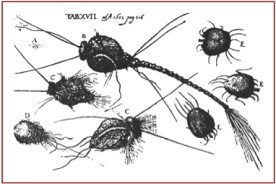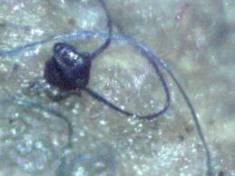FOLKSINGER JONI MITCHELL’S BATTLE WITH MORGELLONS, THE NEW SCOURGE
By Sean Casteel

On March 31, 2015, the legendary folk singer Joni Mitchell was hospitalized after being found unconscious in her Los Angeles home. At the time, it was unclear what had caused her to pass out, but Mitchell, who was 71 at the time of her hospitalization, had long identified herself as sufferer of the strange and controversial condition called Morgellons Disease.
Mitchell told “The Los Angeles Times” in a 2010 interview that Morgellons Disease “seems like it’s from outer space.” In her 2014 autobiography, entitled “Joni Mitchell: In Her Own Words,” she writes, “I couldn’t wear clothing. I couldn’t leave my house for several years. Sometimes it got so I’d have to crawl across the floor. My legs would cramp up, just like a polio spasm. It hit all of the places where I had polio.”
WHAT IS JONI MITCHELL’S BIZARRE MALADY?

The condition has been labeled Mitchell’s “Secret Torment” by one British newspaper, although she never made any effort to keep her condition hidden. Quite the opposite, in fact. But talking publicly about Morgellons is not an easy task, especially when the medical establishment refuses for the most part to believe the problem is even a physical “disease” at all.
Researcher, writer and radio host Tim R. Swartz has studied Morgellons closely for several years and has recently written a book on the subject called “The Final Nail In Your Coffin: A Pox To All Mankind.” (This latest offering from Inner Light/Global Communications is actually another of the company’s generous “two-books-in-one” packages and includes a book on the rumored substance “red mercury,” which is said to put nuclear capabilities in the hands of any terrorist with enough money to buy it.)
According to Swartz, “Those with Morgellons Disease describe feelings of insects scurrying below their skin and have mysterious sores that ooze out blue and white fibers, some as thick as spaghetti strands. Attempts to remove the fibers are said to produce shooting pains radiating from the site.” Sufferers also report fatigue and problems with short-term memory and concentration.
A MOTHER’S CRUSADE
Morgellons takes its name from the efforts of Mary Leitao, who in 2001 was a 43-year-old stay-at-home Mom and former lab technician in South Carolina. Her two-year-old son had begun to develop lesions on the inside of his lip that he said were caused by “bugs.” When Leitao’s son also developed sores and fibers of various colors growing out of his skin, she took him to several doctors, none of whom could find anything biologically wrong with him.

It was Leitao who coined her son’s ailment as “Morgellons,” after a condition described in 1674 by the British author Thomas Browne. Browne said the disorder caused children to “break out with harsh hairs on their backs.” But even the Morgellons Research Foundation says it is doubtful that the 17th century disease is related in any way to modern day Morgellons, Swartz writes.
After being turned away from a series of doctors, Leitao began a public campaign to raise public awareness of Morgellons, after which thousands of fellow sufferers made themselves known. But the medical community held fast to its diagnosis of “delusional parasitosis,” meaning the patient was mistaken in complaining about an infestation by insects under his or her skin but that this false belief could not be corrected by reasoning, persuasion or logical argument.
Meanwhile, all laboratory tests and pathogenic exams returned negative and offered no clinical confirmation of the patients’ complaints. Thus, physicians treat the condition as a mental illness and typically prescribe only antidepressants or other psychiatric medications.
In 2012, The Centers For Disease Control made public the their study of Morgellons, saying that “no common underlying medical condition or infectious source was identified,” and that the fibers were more likely picked up from clothing that got trapped in the sufferers’ sores. Like a Mayo Clinic study done in 2011, the CDC report reaffirmed the “delusional parasitosis” diagnosis.
Shortly after the CDC’s findings were published, Leitao dropped out of sight completely and hasn’t been heard from since. Not even the crusading mother’s contacts in the Morgellons community know where she has gone or have any idea how to contact her.
COULD MORGELLONS BE FROM MARS?
To give the medical community – somewhat begrudgingly – their due, maybe Morgellons is so hard to diagnose and analyze because it’s not an Earth-generated disease at all. Swartz puts forth his own provocative theory thusly: “What makes Morgellons so unique are the weird fibers that grow out of the victim’s skin. No other disease on Earth has this bizarre symptom. So could this mean that Morgellons originated somewhere other than Earth?”
Swartz points to a researcher named Mike Moore who discovered a meteor on a ranch in Texas in the early 1970s. Moore concluded that the unusual rock had formed under extremely dry conditions, was volcanic in origin, and most likely resulted when a large asteroid struck the surface of Mars. Upon first finding the meteorite, Moore concluded that – since it had just come through our atmosphere – it had most likely been “sterilized” by the high heat that melted its outer surface. Ten or fifteen years after first finding the space rock, Moore discovered that “fuzz” or “filaments” were coming out of the crevice that runs through one side of the meteorite.
Moore was left to wonder how a rock from Mars could be growing something that seemed to be alive. It was not until NASA announced in 1996 that they had found the possible remnants of life in a Martian meteorite that Moore began to consider that he was seeing some kind of Martian life growing on his own meteorite. When Moore put a sample from the space rock under a microscope, he found a piece of something that had obviously been some kind of plant or at least some kind of living thing. A later analysis of a section of Moore’s meteor conducted by a lab worker at the Roswell UFO Museum in New Mexico confirmed the presence of a fiber-like creature that moved on the slide as if trying to avoid being stuck there for examination.
THE REAL LIFE “ANDROMEDA STRAIN”?
Rocks blown off of Mars have been falling to Earth throughout history, potentially bringing with them the minute lifeforms that we now call Morgellons. The concept of a disease from outer space infecting unsuspecting Earthlings is not a new one, however.
The first novel by the late Michael Crichton, 1969’s “The Andromeda Strain,” is a techno-thriller documenting the efforts of a team of scientists investigating the outbreak of a deadly extraterrestrial microorganism in Arizona. The story begins when a military satellite returns to Earth. Aerial surveillance reveals that everyone in Piedmont, Arizona, the town closest to where the satellite landed, is apparently dead. The base commander suspects the satellite returned with an extraterrestrial organism and recommends activating Wildfire, a protocol for a government-sponsored team that counters extraterrestrial biological infestation.
After leading the reader through a suspenseful ordeal, the book concludes with the team of scientists heroically saving the day. The Andromeda Strain itself eventually mutates to a benign form and the whole effort is effectively covered up and given no media attention at all.
Crichton received many letters from readers asking if the story told in his bestselling book was somehow true. The novel was published just weeks before the first lunar landing and there was a general concern about whether the astronauts could bring back germs from the moon. The “germs from outer space” theme was treated lightly in some quarters, but, in the years after the novel’s release, any newly-discovered biological agent tended to be referred to as an “Andromeda Strain.” The term became synonymous with any potential pandemic: Marbug, Ebola, Bird Flu, and so on.
At this point, we can potentially add Morgellons Disease to that frightening list.
THERE’S A LAW AGAINST THAT, YOU KNOW
Unsurprisingly, 1969 was also the year that Title 14, Section 1211 of the Code of Federal Regulations went on the books making it illegal for U.S. citizens to have contact with extraterrestrials or their vehicles. Anyone found to have such contact can be jailed for one year and fined $5,000. The NASA administrator is empowered to determine with or without a hearing that a person or object has been “extraterrestrially exposed” and impose an indeterminate quarantine under armed guard, which could not be broken even by court order. There is no limit placed on the number of individuals who could thus be arbitrarily quarantined. The definition of “extraterrestrial exposure” is left entirely up to the NASA administrator.
The legislation was buried in a batch of regulations very few members of government probably bothered to read in its entirety and was slipped onto the books without public debate. In effect, the government of the U.S. has created a whole new criminal class: UFO contactees.
But NASA said the law is really directed at extraterrestrial viruses that could wipe out humankind completely. It may be a kind of whistling in the dark given that simply quarantining a few contactees does not automatically mean some kind of outer space contagion would have no other means of spreading. But it is nevertheless an interesting official acknowledgment that such things are taken seriously at some level of government and that the potential for diseases like Morgellons to have originated in some other world is at least considered a possibility as well.
WHO’S THAT YONDER DRESSED IN BLACK?
But an infestation from another world need not have happened only in the space age.
In a book called “The Gods of Eden,” first published in 1989, author William Bramley recounts the following chilling anecdote:

“In Brandenburg, Germany, there appeared fifteen men with ‘fearful faces and long scythes, with which they cut the oats, so that the swish could be heard from a great distance, but the oats remained standing.’ The visit of these men was followed immediately by a severe outbreak of plague in Brandenburg. Were the ‘scythes’ long instruments designed to spray poison or germ-laden gasses?
“Strange men in black, demons and other terrifying figures were observed in other European communities carrying ‘brooms’ or ‘scythes’ or ‘swords’ that were used to sweep or knock at people’s doors. The inhabitants of these houses fell ill with plague afterwards. It is from these reports that people created the popular image of death as a skeleton, a demon, a man in a black robe carrying a scythe.”
Notes writer Pat Bertram, in his online comments on Bramley’s account of the origins of the Grim Reaper as a familiar cultural symbol, “The Black Death began in Asia and spread to Europe between 1347 and 1350 where it killed over 25 million people, one-third of the population.” While the current thinking is that the plague was spread by rats in overcrowded cities, Bertram writes, not all outbreaks were preceded by rat infestation and the plague often struck isolated communities that had had no contact with infected areas.
Many people in stricken areas reported the disease was caused by “evil-smelling mists” that were frequently accompanied by bright lights and unusual activity in the skies. Sometimes the disease-bearing mist was seen to be coming from rocket-like airships. An epidemic in ancient times was also linked to similar mists, for which Hippocrates, the father of medicine, prescribed large public bonfires that he believed would get rid of the bad air.
AN INVADING SPACE FLOWER?
In the 1978 version of “The Invasion of the Body Snatchers,” one of those rare remakes that is as well thought of by critics as the original version, some of the characters engage in a brief exchange about where the invading “pod army” originates.
Elisabeth Driscoll, the movie’s primary heroine, says, “I have seen these flowers all over. They are growing like parasites on other plants. All of a sudden. Where are they coming from?”To which her friend, Nancy Bellicec, replies, “Outer space?”
Nancy’s husband, Jack Bellicec, interjects: “What are you talking about? A space flower?”
Nancy answers him, “Well, why not a space flower? Why do we always expect metal ships?”
Jack then says, “I NEVER expected metal ships.”

Which is a suggestion we should heed, even those of us in the UFO community. Perhaps Morgellons Disease is just the visible portion of an alien invasion being conducted with “space flowers” that carry with them a disease that our medical community either cannot or will not acknowledge as genuine. Maybe Morgellons is the point of entry for an alien force that eschews metal ships in favor of an insidious disease that has inspired a conspiracy of silence among doctors similar to the cover-up of UFOs themselves in other parts of officialdom.
If you experience the terrifying symptoms of Morgellons – the sensation of bugs crawling beneath your skin, painful wounds that open up for no apparent reason and start to expel strange, cotton-like fibers – don’t expect your family physician to help you. Not even the rich and famous, like Joni Mitchell, have been spared the stigma and frustration that comes with complaining of Morgellons symptoms.
But you can at least arm yourself with the well-researched book on the subject by the aforementioned Tim R. Swartz. Reading “The Final Nail In Your Coffin: A Pox To All Of Mankind” will keep you abreast of the latest research on the disease as well as lead you on a fascinating journey through the myriad possibilities of where it comes from. Swartz does not shy away from including even the unthinkable: Could Morgellons be a new bioweapon designed in Earthly laboratories? A military experiment gone wrong that the civilian medical community cannot even analyze as a disease, let alone cure?
Be watchful for another article about “The Final Nail In Your Coffin,” which will cover one more frightening method for mankind’s extermination – the secret ingredient for a nuclear weapon the size of a softball and cheap enough for the terrorist on a tight budget.








 As the story goes, this is yet another cool place I can freely blog about whatever catches my attention.
As the story goes, this is yet another cool place I can freely blog about whatever catches my attention.